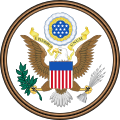| Flag |
Date |
# of stars |
Points |
Stars represent |
Description/comment
|
 United States United States |
1777; 1960 |
50 |
5 |
enumerate US states |
originally 13 stars, 50 stars since 1960, see timeline of the flag of the United States
|
 Chile Chile |
1817 |
1 |
5 |
ideal |
"The star represents a guide to progress and honor"
|
 Brazil Brazil |
1822; 1992 |
27 |
5 |
enumerate States of Brazil |
originally 19 stars, 27 stars since 1992, see Flag of Brazil
|
 Tunisia Tunisia |
1831; 1956 |
1 |
5 |
star and crescent |
based on the Ottoman flag[citation needed]
|
 Turkey Turkey |
1844; 1936 |
1 |
5 |
star and crescent |
the Republic of Turkey was established in 1923 and its Flag Law was passed in 1936, declaring the continued use of the Ottoman flag that had been flown since 1844 (an earlier variant with an eight-pointed star dates to ca. 1793).
|
 Cuba Cuba |
1849;
1902
|
1 |
5 |
ideal |
"The white star in the triangle stands for independence". Based on the flag carried by Narciso López in 1850.
|
 Venezuela Venezuela |
1859; 1930 |
8 |
5 |
enumerate provinces |
various arrangement of the stars in design changes since 1859. Twenty stars during 1859–1863.
|
 Honduras Honduras |
1866 |
5 |
5 |
enumerate provinces |
based on the flag of the Federal Republic of Central America. The five stars also represent the historical provinces of that state, not subdivisions of Honduras itself.
|
 New Zealand New Zealand |
1869; 1902 |
4 |
5 |
Southern Cross |
used as a governmental ensign since 1869, made the official national flag in 1902. Designed by Albert Hastings Markham under a request from Governor George Bowen.
|
 Puerto Rico Puerto Rico |
1895; 1952 |
1 |
5 |
ideal |
The white star in the triangle represents the island of Puerto Rico. Based on the design of the Cuban flag, see Flag of Puerto Rico
|
 Philippines Philippines |
1898 |
3 |
5 |
enumerate island groups |
the three stars represent the three major geographical island groups that compose the Philippines: Luzon, Visayas and Mindanao.
|
 Australia Australia |
1901 |
6 |
7; 5 |
Southern Cross; Commonwealth Star |
seven-pointed stars for the Commonwealth Star and the main stars of the constellation, plus a smaller five-pointed star representing Epsilon Crucis. Based on the winning design in the 1901 Federal Flag Design Competition.
|
 Azerbaijan Azerbaijan |
1918 |
1 |
8 |
star and crescent |
"the eight-pointed star points to the eight letters of the name Azerbaijan (in Arabic script)"[13]
|
 Panama Panama |
1925 |
2 |
5 |
ideal |
"the blue star stands for the purity and honesty of the life of the country; the red star represents the authority and law in the country"
|
 Jordan Jordan |
1928 |
1 |
7 |
ideal |
"The seven points symbolize the seven verses of the first surah of the Qur’an. The seven points also represent faith in one God, humanity, humility, national spirit, virtue, social justice, and aspiration. The star also stands for the unity of the Arab nation."
|
 Vietnam Vietnam |
1945 |
1 |
5 |
ideal |
the Communist Star; "The five-pointed yellow star represents the unity of workers, peasants, intellectuals, traders and soldiers in building socialism"
|
 Pakistan Pakistan |
1947 |
1 |
5 |
ideal |
the star represents "light". The crescent and star symbolize progress and light respectively.
|
 North Korea North Korea |
1948 |
1 |
5 |
ideal |
the Communist Star
|
 People's Republic of China People's Republic of China |
1949 |
5 |
5 |
ideal |
"Five-starred Red Flag" (五星红旗, Wǔxīng Hóngqí), one large star representing the Communist Party surrounded by four smaller ones depicting the four then social classes
|
 Samoa Samoa |
1949 |
5 |
5 |
Southern Cross |
|
 Somalia Somalia |
1954 |
1 |
5 |
ideal |
"Star of Unity"
|
 European Union European Union
|
1955; 1985
|
12
|
5
|
ideal
|
"unity among Europeans". Believed to also be a reference to the Catholic iconographic tradition of showing the Blessed Virgin Mary as the Woman of the Apocalypse, wearing a "crown of twelve stars".[14]
|
 Ghana Ghana |
1957 |
1 |
5 |
ideal |
"the lodestar of African freedom"
|
 Central African Republic Central African Republic |
1958 |
1 |
5 |
ideal |
The star "guides the steps of the Central African people towards freedom and emancipation."
|
 Syrian Republic Syrian Republic |
1958; 1980 |
2 |
5 |
enumerate states |
The 1958 flag was that of the United Arab Republic. The two stars originally represented Syria and Egypt as member states of that entity.
|
 Mauritania Mauritania |
1959 |
1 |
5 |
star and crescent |
|
 Senegal Senegal |
1960 |
1 |
5 |
|
The five points of the star are said to recall the human ideogram which was displayed in the middle of the flag of the former Mali Federation.[citation needed]
|
 Togo Togo |
1960 |
1 |
5 |
ideal |
"hope"[citation needed]
|
 Algeria Algeria |
1962 |
1 |
5 |
star and crescent |
|
 Malaysia Malaysia |
1963 |
1 |
14 |
enumerate states |
a 14-pointed star alongside a crescent, representing the 13 member states plus the federal government
|
 Singapore Singapore |
1965 |
5 |
5 |
ideal |
five stars alongside a crescent, representing "democracy, peace, progress, justice and equality". According to Lee Kuan Yew, the Chinese population wanted five stars (influenced by the flag of the People's Republic of China) and the Muslim population wanted a crescent moon.
|
 Burundi Burundi |
1967 |
3 |
6 |
ideal |
"Unity, Work, Progress"
|
 Nauru Nauru |
1967 |
1 |
12 |
enumerate tribes |
|
 Papua New Guinea Papua New Guinea |
1971 |
5 |
5 |
Southern Cross |
|
 Guinea-Bissau Guinea-Bissau |
1973 |
1 |
5 |
ideal |
"the Black Star of Africa"
|
 Grenada Grenada |
1974 |
7 |
5 |
enumerate parishes |
|
 Angola Angola |
1975 |
1 |
5 |
ideal |
in origin imitating the Communist Star
|
 Cameroon Cameroon |
1975 |
1 |
5 |
ideal |
"star of unity"
|
 Suriname Suriname |
1975 |
1 |
5 |
ideal |
"The star represents the unity of all ethnic groups"
|
 São Tomé and Príncipe São Tomé and Príncipe |
1975 |
2 |
5 |
enumerate islands |
|
 Tuvalu Tuvalu |
1976 |
9 |
5 |
enumerate islands |
The stars are arranged in imitation of the geographic location of the islands of Tuvalu
|
 Djibouti Djibouti |
1977 |
1 |
5 |
ideal |
"The red star signifies the unity of the diverse state."
|
 Solomon Islands Solomon Islands |
1977 |
5 |
5 |
enumerate islands |
|
 Dominica Dominica |
1978 |
10 |
5 |
enumerate parishes |
|
 Marshall Islands Marshall Islands |
1979 |
1 |
24 |
enumerate districts |
the points of the stars enumerate the electoral districts
|
 Federated States of Micronesia Federated States of Micronesia |
1979 |
4 |
5 |
enumerate states |
Based on the Flag of the US Trust Territory of the Pacific, each star represents a constitutional State (Yap, Chuuk, Pohnpei, and Kosrae)
|
 Saint Kitts and Nevis Saint Kitts and Nevis |
1983 |
2 |
5 |
ideal / enumerate islands |
"hope and liberty, or Saint Kitts and Nevis"
|
 Burkina Faso Burkina Faso |
1984 |
1 |
5 |
ideal |
"the guiding light of the revolution"
|
 Croatia Croatia |
1990 |
2 |
6 |
morning star |
The stars are part of the coat of arms of Croatia. One star is part of the coat of arms of the Illyrian movement, and the other is part of the coat of arms of Slavonia.
|
 Slovenia Slovenia |
1991 |
3 |
6 |
ideal |
"democracy", inspired by the historical coat of arms of the Counts of Celje[15]
|
 Uzbekistan Uzbekistan |
1991 |
12 |
5 |
ideal |
a crescent and twelve stars, representing the "ancient calendar cycle"
|
 Tajikistan Tajikistan |
1992 |
7 |
5 |
seven stars on heaven's mountains |
|
 Cape Verde Cape Verde |
1992 |
10 |
5 |
enumerate islands |
|
 Bosnia and Herzegovina Bosnia and Herzegovina |
1998 |
8 ("∞") |
5 |
ideal |
a diagonal line of seven five-pointed stars, plus two half-stars cut off by the flag boundary. The stars represent "Europe" and are intended to be "infinite" in number.
|
 Comoros Comoros |
2001 |
4 |
5 |
enumerate islands |
four stars alongside a crescent
|
 Turkmenistan Turkmenistan |
2001 |
5 |
5 |
enumerate provinces |
five stars alongside a crescent
|
 East Timor East Timor |
2002 |
1 |
5 |
ideal |
"the light that guides"
|
 South Sudan South Sudan |
2005 |
1 |
5 |
ideal |
"the Star of Bethlehem, represents the unity of the states of South Sudan"
|
 Democratic Republic of the Congo Democratic Republic of the Congo |
2007 |
1 |
5 |
ideal |
derived from the flag of Congo Free State (1885)
|
 Myanmar Myanmar |
2010 |
1 |
5 |
ideal |
"unity"
|
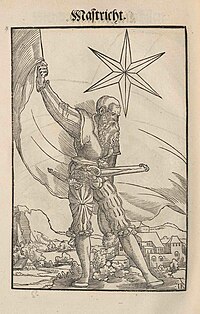






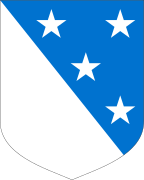
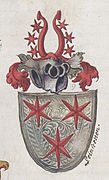
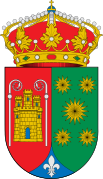
![Coat of arms of the de Béthune family [fr]](https://upload.wikimedia.org/wikipedia/commons/thumb/7/72/Blason_famille_de_B%C3%A9thune_%28Belgique%29.svg/164px-Blason_famille_de_B%C3%A9thune_%28Belgique%29.svg.png)




